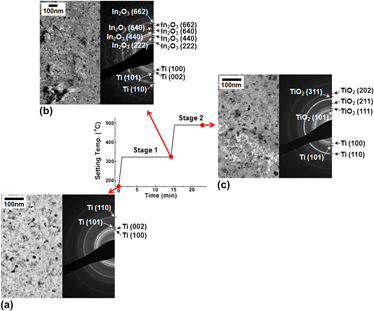Crossref Citations
This article has been cited by the following publications. This list is generated based on data provided by
Crossref.
Xu, Rui
He, Jian
Song, Yang
Li, Wei
Zaslavsky, A.
and
Paine, D. C.
2014.
Contact resistance improvement using interfacial silver nanoparticles in amorphous indium-zinc-oxide thin film transistors.
Applied Physics Letters,
Vol. 105,
Issue. 9,
Hu, W.
and
Peterson, R. L.
2014.
Molybdenum as a contact material in zinc tin oxide thin film transistors.
Applied Physics Letters,
Vol. 104,
Issue. 19,
Lee, Sunghwan
and
Paine, David C.
2014.
Metallization selection and the performance of amorphous In-Zn-O thin film transistors.
Applied Physics Letters,
Vol. 104,
Issue. 25,
Song, Yang
Xu, Rui
He, Jian
Siontas, Stylianos
Zaslavsky, Alexander
and
Paine, David C.
2014.
Top-Gated Indium–Zinc–Oxide Thin-Film Transistors With In Situ Al2O3/HfO2 Gate Oxide.
IEEE Electron Device Letters,
Vol. 35,
Issue. 12,
p.
1251.
Park, Chanhee
Lim, Yooseong
Ha, Seungsoo
Im, Yongjin
Jang, Minhyung
Choi, Seung‐il
Park, Ji‐in
and
Yi, Moonsuk
2015.
Effect on electrical performance of titanium co‐sputtered IZO active‐channel thin‐film transistor.
Journal of the Society for Information Display,
Vol. 23,
Issue. 8,
p.
371.
Song, Yang
Zaslavsky, A.
and
Paine, D.C.
2016.
High performance top-gated indium–zinc–oxide thin film transistors with in-situ formed HfO2 gate insulator.
Thin Solid Films,
Vol. 614,
Issue. ,
p.
52.
Reed, Austin S.
Paine, David C.
and
Lee, Sunghwan
2016.
Effect of O2 Fraction in the Sputter Gas on the Electrical Properties of Amorphous In-Zn-O and the Thin Film Transistor Performance.
Journal of Electronic Materials,
Vol. 45,
Issue. 12,
p.
6310.
Lee, Sunghwan
Song, Yang
Park, Hongsik
Zaslavsky, A.
and
Paine, D.C.
2017.
Channel scaling and field-effect mobility extraction in amorphous InZnO thin film transistors.
Solid-State Electronics,
Vol. 135,
Issue. ,
p.
94.
Song, Yang
Katsman, Alexander
Butcher, Amy L.
Paine, David C.
and
Zaslavsky, Alexander
2017.
Temporal and voltage stress stability of high performance indium-zinc-oxide thin film transistors.
Solid-State Electronics,
Vol. 136,
Issue. ,
p.
43.
Drewelow, Grant
Reed, Austin
Stone, Chandon
Roh, Kwangdong
Jiang, Zhong-Tao
Truc, Linh Nguyen Thi
No, Kwangsoo
Park, Hongsik
and
Lee, Sunghwan
2019.
Work function investigations of Al-doped ZnO for band-alignment in electronic and optoelectronic applications.
Applied Surface Science,
Vol. 484,
Issue. ,
p.
990.
Peng, Hao
Chang, Baozhu
Fu, Haishi
Yang, Huan
Zhang, Yuqing
Zhou, Xiaoliang
Lu, Lei
and
Zhang, Shengdong
2020.
Top-Gate Amorphous Indium-Gallium-Zinc-OxideThin-Film Transistors With Magnesium Metallized Source/Drain Regions.
IEEE Transactions on Electron Devices,
Vol. 67,
Issue. 4,
p.
1619.
Reed, Austin
Stone, Chandon
Roh, Kwangdong
Song, Han Wook
Wang, Xingyu
Liu, Mingyuan
Ko, Dong-Kyun
No, Kwangsoo
and
Lee, Sunghwan
2020.
The role of third cation doping on phase stability, carrier transport and carrier suppression in amorphous oxide semiconductors.
Journal of Materials Chemistry C,
Vol. 8,
Issue. 39,
p.
13798.
Lee, Dong Hun
Park, Honghwi
Clevenger, Michael
Kim, Hyeonghun
Kim, Chung Soo
Liu, Mingyuan
Kim, Giyong
Song, Han Wook
No, Kwangsoo
Kim, Sung Yeol
Ko, Dong-Kyun
Lucietto, Anne
Park, Hongsik
and
Lee, Sunghwan
2021.
High-Performance Oxide-Based p–n Heterojunctions Integrating p-SnOx and n-InGaZnO.
ACS Applied Materials & Interfaces,
Vol. 13,
Issue. 46,
p.
55676.
Liu, Mingyuan
Wang, Xingyu
Wook Song, Han
Kim, Hyeonghun
Clevenger, Michael
Ko, Dong-Kyun
No, Kwangsoo
and
Lee, Sunghwan
2021.
Origin of an unintended increase in carrier density of ternary cation-based amorphous oxide semiconductors.
Applied Surface Science,
Vol. 556,
Issue. ,
p.
149676.
Yum, Woong-Sun
Lee, Sang-Youl
Lim, Hyun-Soo
Choi, Rak-Jun
Oh, Jeong-Tak
Jeong, Hwan-Hee
and
Seong, Tae-Yeon
2021.
Improved Reliability of 278 nm Deep Ultraviolet AlGaN-Based Flip-Chip Light Emitting Diodes by Using ITO/Al Contact.
ECS Journal of Solid State Science and Technology,
Vol. 10,
Issue. 4,
p.
045002.
Liu, Mingyuan
Qin, Fei
Rothschild, Molly
Zhang, Yuxuan
Lee, Dong Hun
No, Kwangsoo
Song, Han Wook
and
Lee, Sunghwan
2022.
The Effect of Bias Stress on the Performance of Amorphous InAlZnO-Based Thin Film Transistors.
Journal of Electronic Materials,
Vol. 51,
Issue. 4,
p.
1813.
Sung, Taehoon
Song, Min-Kyu
Jung, Se-Yeon
Lee, Sein
Song, Young-Woong
Park, Solah
and
Kwon, Jang-Yeon
2022.
Vacuum-free solution-based metallization (VSM) of a-IGZO using trimethylaluminium solution.
RSC Advances,
Vol. 12,
Issue. 6,
p.
3518.
Qin, Fei
Zhang, Yuxuan
Park, Honghwi
Kim, Chung Soo
Lee, Dong Hun
Jiang, Zhong-Tao
Park, Jeongmin
No, Kwangsoo
Park, Hongsik
Song, Han Wook
and
Lee, Sunghwan
2022.
Factors Determining the Resistive Switching Behavior of Transparent InGaZnO‐Based Memristors.
physica status solidi (RRL) – Rapid Research Letters,
Vol. 16,
Issue. 7,
Jeon, Sori
Lee, Kwang-Heum
Lee, Seung-Hee
Cho, Seong-In
Hwang, Chi-Sun
Ko, Jong Beom
and
Park, Sang-Hee Ko
2023.
Contact properties of a low-resistance aluminum-based electrode with metal capping layers in vertical oxide thin-film transistors.
Journal of Materials Chemistry C,
Vol. 11,
Issue. 41,
p.
14177.
Pan, Meiyan
Fu, Yifei
Zang, Yujia
Zheng, Mengjie
Chen, Hao
He, Xinyi
Lu, Yanxin
and
Chen, Yihang
2023.
Reversibly reconfigurable GSST metasurface for broadband beam steering and achromatic focusing in the long-wave infrared.
Optics Express,
Vol. 31,
Issue. 14,
p.
22554.

 200 °C), while a-IZO metallized with Mo remains amorphous. The effects of the unstable Ti/IZO interface are shown to include: vacancy injection, enhanced amorphous-to-crystal transformation kinetics, interfacial oxide formation, and the lateral growth on adjacent IZO of rutile TiO2 needles.
200 °C), while a-IZO metallized with Mo remains amorphous. The effects of the unstable Ti/IZO interface are shown to include: vacancy injection, enhanced amorphous-to-crystal transformation kinetics, interfacial oxide formation, and the lateral growth on adjacent IZO of rutile TiO2 needles.